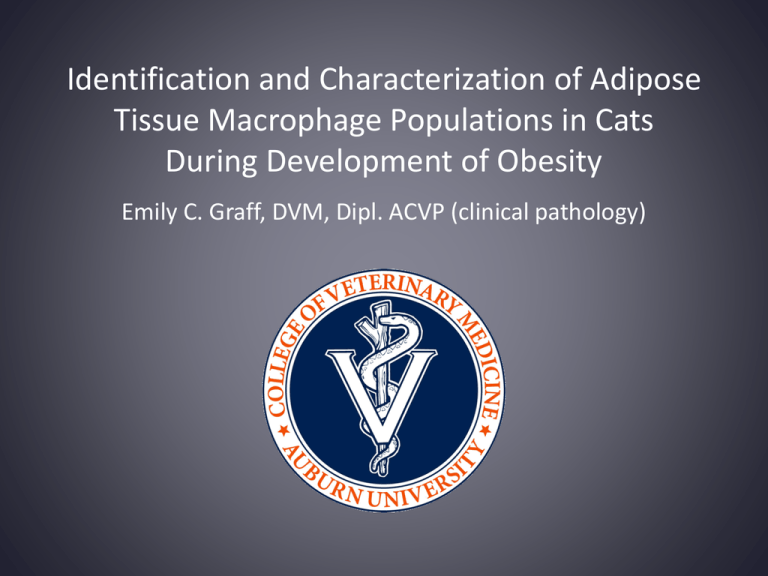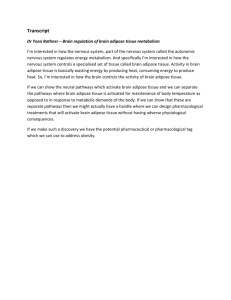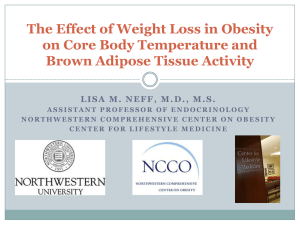Emily C. Graff, DVM, Dipl. ACVP - The ACVP/STP Coalition for
advertisement

Identification and Characterization of Adipose Tissue Macrophage Populations in Cats During Development of Obesity Emily C. Graff, DVM, Dipl. ACVP (clinical pathology) U.S. Obesity Trends Obesity = Adipose Tissue Dysregulation Adipose tissue- cytology Radin et al. Vet Clin Pathol 2009 Adipose tissue remodeling = altered adipokine regulation and chronic low grade inflammation Macrophages (MΦ) & Crown-Like Structures Weisberg et al. J Clin Invest. 2003 Cinti et al Journal of Lipid Research, 2005 “Adipose tissue macrophage numbers increase in obesity and participate in inflammatory pathways that are activated in adipose tissues of obese individuals.” Weisberg et al. JCI 112 (2003) Macrophage Polarity Obesity-Associated Adipose Tissue Inflammation Ouchi et al Nature Reviews immunology. Feb. 2011 M2 > M1 M1 > M2 Companion Animal Obesity The Cat as a Model for Human Obesity, Nutrition and Diabetes • Similarities: – – – – Nutritional disorder Risk factor for T2DM Lifestyle Pathogenesis • Amyloid deposition • β-cell loss – GLUT-4 expression O’brien Molecular and Cellular Endocrinology 2002 • Differences: – Obligate carnivores – Do not develop atherosclerosis or hypertension Do Obese Cats Develop a Systemic Inflammatory Response? – Possibly No! • Tvarijonaviciute et al. Domestic Animal Endocrinology 2012 – Study: Weight-loss in 37 client owned cats – Cats: No change in serum amyloid A or serum haptaglobin – People: Weight gain is associated with increased C-reactive protein • Hoenig et al. Obesity 2013 – Study: Longitudinal feline obesity model with 100% weight gain over 1 year – Cats: Significant alterations in serum adipokines, but no significant increase in serum concentrations of IL-1, IL-6 or TNF-α – People: Weight gain is associated with marked adipokine dysregulation and significant increases in inflammatory cytokines Do Obese Cats Develop a Systemic Inflammatory Response? – Possibly Yes! • Miller et al. Journal of Nutrition 1998 – Tumor Necrosis Factor-α Levels in Adipose Tissue of Lean and Obese Cats • Van de Velde et al. British Journal of Nutrition 2013 – The cat as a model for human obesity: insights into depotspecific inflammation associated with feline obesity – Increased adipocyte cell size, altered adipokine expression and increased pro-inflammtory cytokines in tissue Identification of Depot Specific Inflammation Associated with Feline Obesity Gap in Knowledge • What is actually contributing to the adipose tissue inflammation? – Adipocytes – Adipose tissue macrophages • What, if any, are the systemic inflammatory patterns associated with obesity in cats? – Biomarkers of inflammation (cytokines) – Cellular markers of inflammation Initial Objective – Preliminary Data Identify adipose tissue macrophages (ATM) and crown-like structures (CLS) in feline adipose tissue Two methods: 1. Immunohistochemistry of formalin fixed adipose tissue 2. Isolation of the stromal vascular fraction (SVF) followed by flow cytometric analysis Subcutaneous Adipose Tissue H&E 200X CD18 200X Lysozyme 200X Alpha-1 Antitrypsin Flow Cytometric Evaluation of SVF • 4 g adipose tissue digested in collagenase • Isolation of SVF via filtration and differential centrifugation • Accuri C6 flow cytometer and Beckman Coulter MoFlo XDP for FACS to identify and sort cell populations • PI stain to determine cell viability • Prepared cytospin preparation of the cells for cytologic identification Flow Cytometry & Cytospin Results R1 R2 Preliminary Data Results • Immunohistochemistry: – Lean cats do contain rare adipose tissue macrophages • Isolation of SVF and flow cytometry: – Concentration of adipose tissue macrophages – Viable macrophages can be isolated from feline adipose tissue Identify and characterize feline macrophage populations in adipose tissue during the development of obesity Central hypothesis: During the development of obesity cats will demonstrate… – – – – – increased numbers of macrophages increased proportion of M1 type macrophages increased adipose tissue inflammation adipokine dysregulation systemic inflammation Specific Aims • Specific Aim 1: – Identify and enumerate macrophages in lean and obese feline adipose tissue • Specific Aim 2: – Confirm phenotype of the populations based on surface receptor expression and cytokine mRNA expression • Specific Aim 3: – Determine circulating feline adipokine profiles, specifically adiponectin, leptin, serum amyloid-A, TNFα and IL-6 in cats as changes in adipose inflammation occur Feline Obesity Model 10% Baseline Lean 20% 30% 40% Midpoint Overweight 50% 60% 70% End of Study Obese • Each cat will serve as their own control • Cats will be fed same diet throughout the study • CT scan to evaluate adipose tissue deposition (baseline and end of study) • Samples collected – Adipose tissue – Visceral and subcutaneous (baseline and end of study) – Serum ( at each 10% increase in weight gain) cat images from: http://www.healthyweightpet.com/uk/cat Sample Evaluation • Perform IHC evaluation – Adipose tissue macrophages – Crown-like-structures • Isolate SVF & sort cell populations – Identify and quantify cell populations • Evaluate systemic markers of Inflammation – Adipokines – Inflammatory cytokines – Acute phase proteins • Evaluate insulin sensitivity Expand Evaluation of SVF • Evaluate M1 and M2 macrophage populations – Apply specific macrophage surface markers – RT-PCR for M1 and M2 cytokine profiles Classical - M1 Alternative - M2 General Surface marker CD11c CD163 CD18 Cytokines expressed TNFα, IL-6, IL-12 IL-10, IL-1 NA Induced by LPS (th1 cytokines) IL-10 (th2 cytokines) NA Cat Colony - Growth and Weight Neutering and recovery Expected Outcomes As obesity develops we expect to find: – Increased numbers of adipose macrophages – Increased percentage of M1 type macrophages – Increased adipose tissue inflammation – Altered systemic and tissue adipokine regulation – Increased circulating inflammatory markers Summary • Obesity and obesity-induced peripheral insulin resistance are epidemic in both people and companion animals • Adipokine dysregulation and chronic inflammation are features of obesity-induced peripheral insulin resistance in humans • Cats are naturally occurring model of human obesity and T2DM • Further work is needed to evaluate feline obesity- associated inflammation Thank you Dr. Robert L. Judd Dr. Desiree Wanders Olga Norris Ally Emmert Nathan Gray Dr. Elizabeth G. Welles Dr. Beth Spangler Dr. Robert Kemppainen Dr. Ellen Behrend Dr. Ray Dillon Dr. D.M. Tillson Sharron Barney Dr. R.C. Bird Ali Bird Dr. Pat Rynders Dr. Bettina Schemera Dr. Bob Cole Dr. Emily Graff was partially supported by the Charles and Sharron Capen Fellowship in Veterinary Pathology organized by the American College of Veterinary Pathologists and Society of Toxicologic Pathology Coalition for Veterinary Pathology Fellows.








